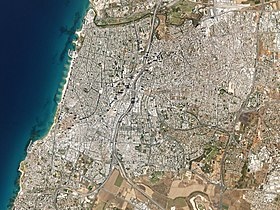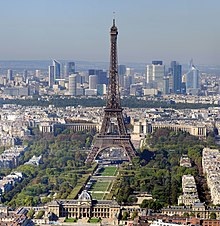|
|
| |
|
|
| |
|
|
|
|
| |
 |
| Downtown Pittsburgh
sits at the confluence of the Monongahela and
Allegheny rivers, which become the Ohio. |
Cities
A city is a large and permanent human settlement. Cities
generally have extensive systems for housing,
transportation, sanitation, utilities, land use, and
communication. Their density facilitates interaction
between people and businesses, sometimes benefiting both
parties in the process.
Historically city-dwellers have been a small proportion
of humanity overall, but today, following two centuries
of unprecedented and rapid urbanization, half of the
world population is said to live in cities. Present-day
cities usually form the core of larger metropolitan
areas and urban areas, creating numerous commuters
traveling towards city centers for employment,
entertainment, and edification. |
|
Definition
There is no rule that is used all over the world to
decide why some places are called "city" and other
places are called "town".
Some things that make a city are: |
- A long history.
- A large population.
- A centre where business and local
government takes place.
- Special powers called town
privileges which have been given by the government of
the country, or its ruler. This was done especially
during the Middle Ages.
- Having a cathedral or a university.
This rule is found in the United Kingdom. The smallest
"cathedral cities" are St. David's and St Asaph's which
are both in Wales, and Ripon and Wells which are in
England.
|
|
In American English, people often call all places cities.
(See below: Size of cities) |
|
 |
| This aerial view of
the Gush Dan metropolitan area in Israel shows
the geometrically planned city of Tel Aviv
proper (upper left) as well as Givatayim to the
east and some of Bat Yam to the south. Tel
Aviv's population is 433,000; the total
population of its metropolitan area is
3,785,000. |
Size of cities
The sizes of cities can be very different. This depends
on the type of city that it is. Cities that were built
hundreds of years ago and which have not changed much,
are very much smaller than modern cities. There are two
main reasons. One reason is that old cities often have a
city wall, and most of the city is inside it. Another
important reason is that the streets in old cities are
often narrow. If the city got too big, it was hard for a
cart carrying food to get to the market place. People in
cities need food, and the food always has to come from
outside the city. Cities that were on a river like
London could grow much bigger than cities that were on a
mountain like Sienna in Italy, because the river made a
transport route for carrying food and other goods, as
well as for transporting people. London has been
changing continually for hundreds of years, while Siena,
which was a very important city in the 1300s has changed
very little in 700 years. Modern cities with modern
transport systems can grow very large, because the
streets are wide enough for cars, buses and trucks, and
there are often railway lines as well.
In the US, the word city is often used for towns that
are not very big. When the first European people went to
America, they gave the name "city" to new places. They
hoped the places would be great cities in the future.
For example, Salt Lake City was the name given to a
village of 148 people. When they started building the
town they made street plans and called it Great Salt
Lake City (for the nearby Great Salt Lake). Now, 150
years later, it really is a big city.
In modern times many cities have grown bigger and
bigger. The whole area is often called a "metropolis"
and can sometimes includes several small ancient towns
and villages. The metropolis of London includes the City
of London, the City of Westminster and many old villages
such as Notting Hill, Southwark, Richmond, Greenwich and
etc. The part that is officially known as the "City of
London" only takes up one square mile. The rest is known
as "Greater London". Many other cities have grown in the
same way.
These giant cities can be exciting places to live, and
many people can find good jobs there, but modern cities
also have many problems. Many people cannot find jobs in
the cities and have to get money by begging or by crime.
Cars, factories, and waste create a lot of pollution
that makes people sick. |
 |
| Paris is one of the
best-known cities in the world. |
Urban History is history of civilization. The first
cities were made in ancient times, as soon as people
began to create civilization. Famous ancient cities
which fell to ruins included Babylon, Troy, Mycenae and
Mohenjo Daro.
Benares in northern India is one among the ancient
cities which has a history of more 3000 years. Other
cities that have existed since ancient times are Athens
in Greece, Rome and Volterra in Italy, Alexandria in
Egypt and York in England.
In Europe, in the Middle Ages, being a city was a
special privilege, granted by nobility. Cities that fall
into this category, usually had (or still have) city
walls. The people who lived in the city were privileged
over those who did not. Medieval cities that still have
walls include Carcassonne in France, Tehran in Iran,
Toledo in Spain and Canterbury in England.
In the United Kingdom, a city is a town which people
have always called a city, or which has got the name
"city" status by royal charter (a special paper from the
king or queen). Cities usually get this because they
have a special number of people or are important. In the
past, cities got that name if they had a cathedral or a
university. Some cathedral cities, for example St
David's, are small, and people do not normally think of
them as cities. Cities that became cities because of
their university generally grow because more people move
there to be educated at the university colleges. The
university cities of Oxford and Cambridge are famous
throughout the world. The largest city is Shanghai,
while the fastest growing is Dubai. The smallest city in
the UK is Wells. |
|
World's largest cities
These cities have more than 10 million people: |
- Shanghai, China - 23 million
- Tokyo, Japan - 20+ million
- Mexico City, Mexico - 18 million
- Mumbai, India - 18 million
- São Paulo, Brazil - 18 million
- Lagos, Nigeria - 13 million
- Calcutta, India - 13 million
- Buenos Aires, Argentina - 12 million
- Seoul, South Korea - 12 million
- Beijing, China - 12 million
- Karachi, Pakistan - 12 million
- Dhaka, Bangladesh - 11 million
- Manila, Philippines - 11 million
- Cairo, Egypt - 11 million
- Osaka, Japan - 11 million
- Rio de Janeiro, Brazil - 11 million
- Tianjin, China - 10 million
- Moscow, Russia - 10 million
- Lahore, Pakistan - 10 million
|
|
|
 Kiddle: Cities Kiddle: Cities
Wikipedia: Cities |
|
|
|
|
|
|
|
|
|
|
|
|
|
|
|
|
Search Fun Easy English |
|
|
|
|
|
|
|
|
|
|
|
|
|
|
|
About
Contact
Copyright
Resources
Site Map |